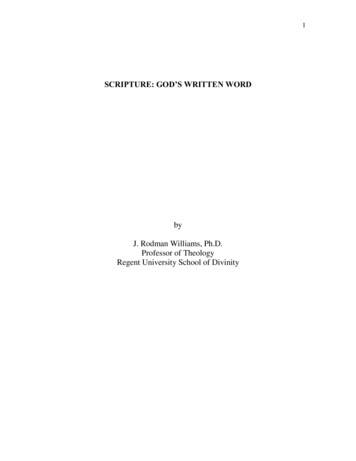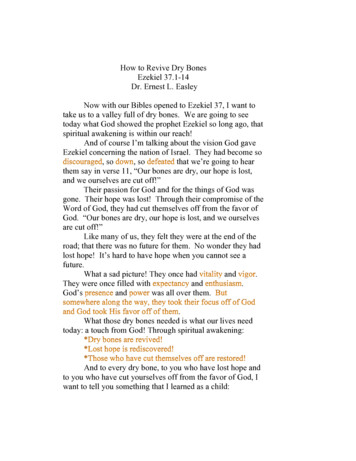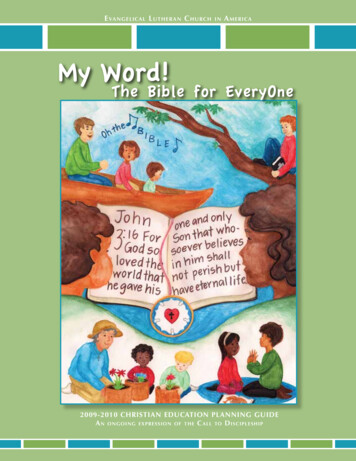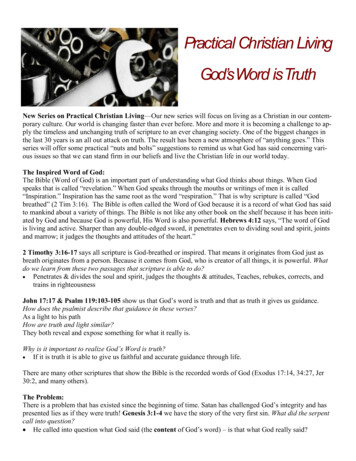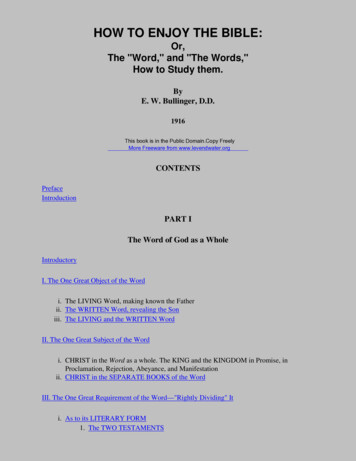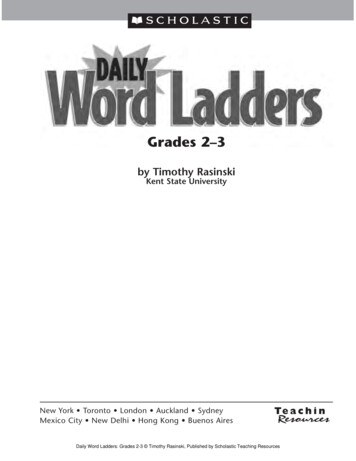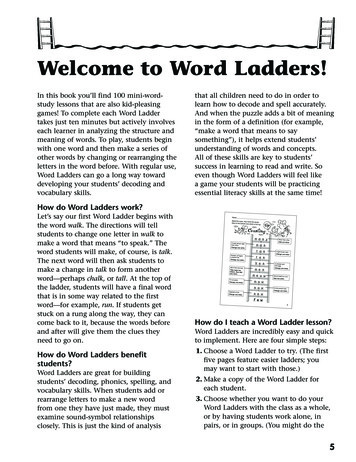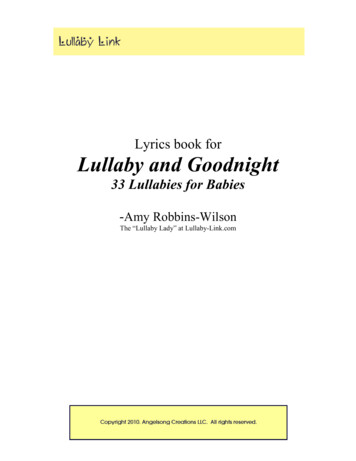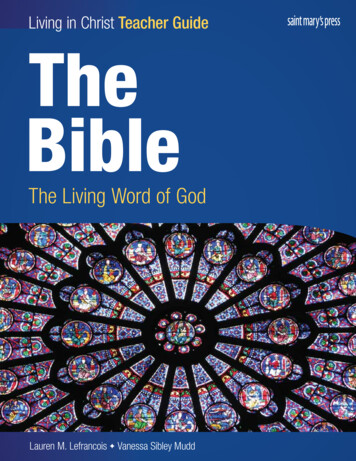
Transcription
Living in Christ Teacher GuideTheBibleThe Living Word of GodLauren M. Lefrancois Vanessa Sibley Mudd
The BibleThe Living Word of GodTeacher guideLiving in ChristLauren M. Lefrancois and Vanessa Sibley MuddTo access the ancillary teachingresources for this course, go tohttp://www.smp.org/resourcecenter/books/
To Rory, Kate, Mary, and Liam, for all you have taught meand for all those you continue to teach.LaurenThank you to my family and colleagues for your supportas well as to all of my students for teaching me what ismost important in education.VanessaThe publishing team included Gloria Shahin, editorial director; ChristineSchmertz Navarro, development editor; prepress and manufacturing coordinated by the production departments of Saint Mary’s Press.Cover Image: The Crosiers / Gene Plaisted, OSCCopyright 2011 by Saint Mary’s Press, Christian Brothers Publications, 702Terrace Heights, Winona, MN 55987-1320, www.smp.org. All rights reserved.Permission is granted to reproduce only the materials intended for distribution tostudents. No other part of this guide may be reproduced by any means withoutthe written permission of the publisher.Thank you to the ninth- and tenth-grade students and the religion faculty atCathedral Catholic High School in Del Mar, California, who piloted unit 6 priorto publication, with special appreciation to Mr. Keith Warrick, who made thispiloting possible. We thank the religion faculty at Calvert Hall, Baltimore; SaintPatrick’s, Chicago; and St. Agnes, Houston, who reviewed the same unit. In addition, thank you to our original June 2006 teacher focus group of Anne Herrick,Gary Meegan, Holly Hoey-Germann, Georgia Skopal, Sr. Katherine Feely, andMichael Greene as well as two early reviewers, Patrick Tiernan and Sr. AnnMarie Lustig, OP.Printed in the United States of America1244ISBN 978-1-59982-081-1, Digital
ContentsIntroduction . . . . . . . . . . . . . . . . . . . . . . . . . . . . . . . . . . . . . . . . . . . . . . . . . 5Units of StudyUnit 1: What Is the Bible? . . . . . . . . . . . . . . . . . . . . . . . . . . . . . . . . . . . .Overview . . . . . . . . . . . . . . . . . . . . . . . . . . . . . . . . . . . . . . . . . . . . . . .Student Book Articles Addressed in this Unit:Article 13 - Sacred Scripture and Sacred TraditionArticle 14 - Divine Inspiration and Biblical InerrancyArticle 15 - From the Spoken to the Written WordArticle 16 - When Was It Written?Article 17 - Setting the Canon of ScriptureArticle 18 - Different Translations: The Same RevelationArticle 19 - A Vocation to Interpret and TeachArticle 20 - Biblical ExegesisArticle 21 - Literary Forms in the BibleArticle 22 - Senses of the ScripturesArticle 23 - Relation to Science and HistoryArticle 24 - Other Avenues to Understanding the ScripturesArticle 25 - The Old Testament: Old Does Not Mean Out of DateArticle 26 - The Old Testament: General OverviewArticle 28 - The New Testament: Why Is It called “New”?Article 29 - The New Testament: General OverviewArticle 30 - The Canon of the New TestamentLearning Experiences . . . . . . . . . . . . . . . . . . . . . . . . . . . . . . . . . . . . .Handouts . . . . . . . . . . . . . . . . . . . . . . . . . . . . . . . . . . . . . . . . . . . . . . .14141844Unit 2: How Can We Know God? Revelation, Inspiration, and Vocation . 66Overview . . . . . . . . . . . . . . . . . . . . . . . . . . . . . . . . . . . . . . . . . . . . . . . 66Student Book Articles Addressed in this Unit:Article 1 – Longing for GodArticle 2 – God’s InvitationArticle 3 – Happiness in God AloneArticle 4 – Saint Augustine and the Four Objects of LoveArticle 5 – The Sacred Scriptures and Natural RevelationArticle 6 – Natural Revelation and the Wisdom of the ChurchFathersArticle 7 – Natural Revelation and Scholastic TheologyArticle 8 – Natural Revelation: Vatican Council I to the PresentArticle 71 – The Study of the Sacred ScripturesArticle 72 – The Centrality of the Scriptures in the Mass and OtherLiturgies
Article 73 – The Liturgy of the Hours: A Window into the DailyRhythms of LifeArticle 74 – The Lord’s Prayer: Rooted in the ScripturesArticle 75 – The Scriptures and the Rules of the SaintsLearning Experiences . . . . . . . . . . . . . . . . . . . . . . . . . . . . . . . . . . . . . 70Handouts . . . . . . . . . . . . . . . . . . . . . . . . . . . . . . . . . . . . . . . . . . . . . . . 89Unit 3: What Is Salvation History? . . . . . . . . . . . . . . . . . . . . . . . . . . . .Overview . . . . . . . . . . . . . . . . . . . . . . . . . . . . . . . . . . . . . . . . . . . . . .Student Book Articles Addressed in this Unit:Article 9 - Salvation History: God’s RevelationArticle 10 - Salvation History in the Old TestamentArticle 11 - Jesus Christ: The Fullness of All RevelationArticle 12 - The Transmission of Divine RevelationArticle 31 - Creation: In the BeginningArticle 32 - Sin and God’s ResponseLearning Experiences . . . . . . . . . . . . . . . . . . . . . . . . . . . . . . . . . . . .Handouts . . . . . . . . . . . . . . . . . . . . . . . . . . . . . . . . . . . . . . . . . . . . . .104104108128Unit 4: God Calls the Early Leaders of Israel . . . . . . . . . . . . . . . . . . . 152Overview . . . . . . . . . . . . . . . . . . . . . . . . . . . . . . . . . . . . . . . . . . . . . . 152Student Book Articles Addressed in this Unit:Article 33 - AbrahamArticle 34 - Isaac, Jacob, and JosephArticle 35 - A People EnslavedArticle 36 - The ExodusArticle 37 - Building Trust in GodArticle 38 - The Ten CommandmentsLearning Experiences . . . . . . . . . . . . . . . . . . . . . . . . . . . . . . . . . . . . 156Handouts . . . . . . . . . . . . . . . . . . . . . . . . . . . . . . . . . . . . . . . . . . . . . . .174Unit 5: Israel’s Response to the Covenant under the Judges and Kings .Overview . . . . . . . . . . . . . . . . . . . . . . . . . . . . . . . . . . . . . . . . . . . . . .Student Book Articles Addressed in this Unit:Article 39 - Joshua: God Is on Our SideArticle 40 - Judges: The Book of DeliverersArticle 41 - From Saul to Solomon: The Desire for UnityArticle 42 - David: Recognizing a ServantLearning Experiences . . . . . . . . . . . . . . . . . . . . . . . . . . . . . . . . . . . .Handouts . . . . . . . . . . . . . . . . . . . . . . . . . . . . . . . . . . . . . . . . . . . . . .196196200218Unit 6: The Prophets: Bearers of Challenge and Hope . . . . . . . . . . . . 234Overview . . . . . . . . . . . . . . . . . . . . . . . . . . . . . . . . . . . . . . . . . . . . . . 234Student Book Articles Addressed in this Unit:Article 43 - The Prophets: A Radical RedemptionArticle 44 - Major and Minor Prophets
Article 45 - Ezekiel: Challenging Idolatry and InjusticeArticle 46 - Jeremiah: Success in the LordArticle 47 - Isaiah: The Long-Awaited OneLearning Experiences . . . . . . . . . . . . . . . . . . . . . . . . . . . . . . . . . . . . 238Handouts . . . . . . . . . . . . . . . . . . . . . . . . . . . . . . . . . . . . . . . . . . . . . . 251Unit 7: Jesus Fulfills the Covenant . . . . . . . . . . . . . . . . . . . . . . . . . . .Overview . . . . . . . . . . . . . . . . . . . . . . . . . . . . . . . . . . . . . . . . . . . . . .Student Book Articles Addressed in this Unit:Article 53 - The Central Place of the GospelsArticle 54 - Three Stages in Gospel FormationArticle 55 - Why Four Gospels?Article 56 - The Gospel of MatthewArticle 57 - The Gospel of MarkArticle 58 - The Gospel of LukeArticle 59 - The Central Accounts in the Synoptic GospelsArticle 60 - The Parables and Miracles in the Synoptic GospelsArticle 61 - The Paschal Mystery in the Synoptic GospelsArticle 62 - The Gospel of John: God IncarnateArticle 63 - Signs and MiraclesArticle 64 - The “I Am” StatementsArticle 65 - The Bread of Life and Last Supper DiscoursesArticle 66 - The Passion, Death, and ResurrectionLearning Experiences . . . . . . . . . . . . . . . . . . . . . . . . . . . . . . . . . . . .Handouts . . . . . . . . . . . . . . . . . . . . . . . . . . . . . . . . . . . . . . . . . . . . . .276276280294Unit 8: The First Christians: Witnesses to the New Covenant . . . . . . 310Overview . . . . . . . . . . . . . . . . . . . . . . . . . . . . . . . . . . . . . . . . . . . . . . 310Student Book Articles Addressed in this Unit:Article 67 - The Acts of the ApostlesArticle 68 - The Pauline LettersArticle 69 - The Catholic LettersArticle 70 - The Book of RevelationArticle 76 - Lectio DivinaArticle 77 - The Scriptures and MoralityArticle 78 - Individual and Communal Prayer with the ScripturesArticle 79 - Two Devotional Prayers and Their Scriptural ConnectionsLearning Experiences . . . . . . . . . . . . . . . . . . . . . . . . . . . . . . . . . . . . 314Handouts . . . . . . . . . . . . . . . . . . . . . . . . . . . . . . . . . . . . . . . . . . . . . . 330Appendix 1: Additional Resources . . . . . . . . . . . . . . . . . . . . . . . . . . . . . . 346Appendix 2: Student Book/Teacher Guide Correlation . . . . . . . . . . . . . . 356Acknowledgments . . . . . . . . . . . . . . . . . . . . . . . . . . . . . . . . . . . . . . . . . . 362
Introducing theLiving in Christ SeriesThe Bible: The Living Word of God is the first-semester ninth-grade course in theLiving in Christ series.Saint Mary’s Press developed the Living in Christ series in response tothe needs of important stakeholders in the catechesis process. The courses inthe series follow the sequence and contain the material from the United StatesConference of Catholic Bishops’ “Doctrinal Elements of a Curriculum Framework for the Development of Catechetical Materials for Young People of HighSchool Age” (2008). Each course also contains other material in the studentbook and teacher guide that students should know, understand, and be ableto do. Each course responds to the varied needs that you express, especiallyabout limited time and the range of catechized youth you encounter in yourclasses, offering wisdom from “secular” educational methods that can addressboth time limits and diversity in the classroom.After three years of study, Catholic high school students will understandfoundational concepts about the Bible, Jesus Christ as a member of the Trinity, thePaschal Mystery, the Church, the Sacraments, and morality. They will also haveskills to learn more about their faith by studying the Scriptures, reading primarytheological sources, consulting the Catholic faith community, doing self-reflection,and having conversations with their peers. With your guidance your graduates willpossess a lived faith as they move into their future.The Living in Christ SeriesThe Living in Christ series has a different look and feel from traditional highschool theology textbooks and teaching manuals. r 5IF UFBDIFS HVJEF SBUIFS UIBO UIF TUVEFOU CPPL QSPWJEFT the scopeand sequence for the course. Teaching with the student book is morelike teaching with The Catholic Faith Handbook for Youth (Saint Mary’sPress, 2008) than with a textbook. The sequence of a textbook is importantbecause the content builds on what has come before. A handbook providesmaterial in a sensible order, but because the content does not rely on whathas come before in quite the same way, the material can be presented inseveral different sequences. r 5IF UFBDIFS HVJEF QSPWJEFT ZPV XJUI JEFBT BCPVU IPX UP UFBDI OPU POMZ XJUI UIF TUVEFOU CPPL CVU BMTP XJUI UIF #JCMF SFTPVSDFT PO UIF 4BJOU Mary’s Press Web site (smp.org/LivinginChrist), and other resourcesfound on the Internet. The teacher guide works as a command center for thecourse, providing ways for you to teach key concepts to the students by bringing in a wide variety of resources.5
6The Bible: The Living Word of God r 5IF -JWJOH JO ISJTU TFSJFT JOWJUFT ZPV BT UFBDIFS UP EFWFMPQ ZPVS abilities to facilitate learning. This series asks you to become an expertabout your own students, discern how they learn best, and then lead themto understand main concepts in a way that speaks to their lived experienceand the issues of the day. r 5IF -JWJOH JO ISJTU TFSJFT JOWJUFT UIF TUVEFOUT UP CF NPSF FOHBHFE JO their own learning. This series asks the students to take charge of theirlearning process and to practice what it will mean to be adult Catholics whomust translate scriptural and Church teaching into their real world.These changes will enable the students to consider the most importantconcepts in the course at a deeper level.The Series Web Site: smp.org/LivinginChristIn addition to the teacher guide and student book, the Living in Christ seriesprovides an extensive collection of digital resources for each course to assist youin guiding the learning of your students. The digital resources are sorted on theWeb site by course and unit. For each unit in a course, you will find the followingresources at smp.org/LivinginChrist: r )BOEPVUT All handouts for a unit are provided in multiple digital formats,including Word and rich text formats that you can revise. r .FUIPE BSUJDMFT Method articles explain teaching methods introduced in aunit that might be unfamiliar to some teachers. r 5IFPMPHZ BSUJDMFT Theology articles provide an in-depth exploration ofkey theological concepts presented in a unit to assist you in explaining theconcept and responding to student questions. r 1PXFS1PJOU QSFTFOUBUJPOT Student learning in each unit is enhanced withPowerPoint presentations. Beyond simply repeating student book content,these PowerPoint presentations engage students through reflection anddiscussion. All of the Living in Christ PowerPoint presentations are in aformat that allows you to revise them. r 6TFGVM MJOLT Links to other resources are provided so you can enhanceyour students’ learning with additional resources. The links direct yourstudents to Web sites you can trust, and are continually checked for appropriateness and to ensure that they are active. r 4UVEFOU WPDBCVMBSZ RVJ[ For each unit there is an interactive vocabulary quiz for students. The quiz provides questions to assess students’knowledge of the vocabulary for a unit. Additionally, as the studentsrespond to each vocabulary question, they are provided with the full definition along with a reference to the student book page where the word isdefined and explored so they can read the word in context to deepen theirunderstanding.
Introducing the Living in Christ SeriesAt smp.org/LivinginChrist you will also have access to an online testgenerator, which provides hundreds of additional questions for each course,beyond what is provided in the unit tests. You can use test questions as theyare presented or modify them for your students’ learning needs. You can alsoupload your own questions, which will be formatted by the test generator. Further, the test generator allows you to select the questions you want for inclusionon a test and provides you with an answer key for the custom test you developfor your classroom.Introducing The Bible: The LivingWord of GodThe eight units of The Bible: The Living Word of God lead the students towarda deeper understanding of the Bible and the history of our salvation presentedwithin it. The students learn to navigate the Bible and use basic exegetical skills.They examine the relationship among Revelation, Inspiration, and vocation. Theylearn why salvation history is necessary. They then come to know the peopleof salvation history: the early leaders of Israel, the judges and kings, and theprophets. They come to understand that Jesus Christ is the fulfillment of salvation history and the Israelites’ covenant relationship with God. They learn aboutthe early Christian Church with a focus on Saint Paul and other key figures ofthe time.The majority of the course focuses on the Bible itself and the Old Testament, with the last two units bringing in Christianity. Because the secondcourse, Jesus Christ: God’s Love Made Visible, is a Christology course with astrong scriptural foundation, it would have been redundant to spend an equalamount of time on both the Old and the New Testaments in The Bible course.The authors of this teacher guide had to prioritize which knowledge, skills, andunderstanding would be most important for the students to understand.The course has eight units centered on eight important questions and concepts, or understandings, about the Bible and salvation history. Each unit buildson the knowledge, skills, and understanding of the previous unit. Within eachunit the knowledge, skills, and understanding also build as the unit progresses.The eight units are as follows: r Unit 1: What Is the Bible? r Unit 2: How Can We Know God? Revelation, Inspiration, and Vocation r Unit 3: What Is Salvation History? r Unit 4: God Calls the Early Leaders of Israel r Unit 5: Israel’s Response to the Covenant under the Judges and Kings r Unit 6: The Prophets: Bearers of Challenge and Hope r Unit 7: Jesus Fulfills the Covenant r Unit 8: The First Christians: Witnesses to the New Covenant7
8The Bible: The Living Word of GodThe Structure of Each Unitin This Teacher GuideThis teacher guide offers the teacher one path through each unit, referring thestudents to the student book, the Bible, resources on the Saint Mary’s PressWeb site (smp.org/LivinginChrist), and other Internet resources.The path for each unit has the goal of leading all the students to comprehend four “understandings” with the related knowledge and skills. This curriculum model assumes that you will adjust your teaching according to the needsand capabilities of the students in your class. You do not have to complete everylearning experience provided, and we hope you substitute your own ideas forthose in the teacher guide when needed.Each unit has three basic parts: the Overview, the Learning Experiences,and handouts.The OverviewThe Overview is a snapshot of the whole unit. This section should help youmake connections between the Scripture courses you currently teach and TheBible course. The Overview provides the following information: r the concepts or understandings the students should understand by the endof the unit r the questions the students should be able to answer by the end of the unit r a brief description of the summary assessments (final performance tasks)offered, which will show that the students understand the most importantconcepts r a summary of the steps in the Learning Experiences section (Each step inthe unit builds on the one before but must be adjusted to fit your scheduleand the needs of the students. The use of steps is more flexible than is astructure based on 60-minute periods, for example.) r a list of background material on content and methods that can be found onthe Saint Mary’s Press Web site (smp.org/LivinginChrist) r a list of articles from the student book covered in the unit r a list of Scripture passages used r a list of vocabulary that comes from the student book and from thelearning experiences in the teacher guide
Introducing the Living in Christ SeriesLearning ExperiencesThe instruction and learning occur in this section. Each unit contains a similarprocess for instruction.Preassess Student Knowledge of the ConceptsEach unit opens with one or more options for preassessing what the studentsalready know about a topic. It is useful to know this information as you prepare topresent new material.Preassessing the students’ knowledge can help you determine how to useyour time effectively throughout the unit. It is not worth your time to teach thestudents what they already know or to teach above their heads. Students learnmost effectively when new concepts build on what they already know. Moreoften, you have a mixed group knowledge-wise, which is good, because thestudents can help one another.Present the Final Performance Tasks to the StudentsA final performance task is a type of summary assessment, a means of determining what the students understand, know, and can do after a period of instruction such as a unit. (The unit test is also a summary assessment.)In addition to providing a unit test, we encourage you to assess (determine) student understanding of the four most important concepts in each unitby assigning one of the short projects called final performance tasks. Throughthese projects the students can demonstrate their understanding of the mainconcepts. This assignment allows you to have another snapshot of what thestudents understand.For example, the four understandings for unit 1 are: r The Bible is the story of our salvation and tells us of God’s enduring lovefor humanity. r Bible is a word that means “books” and is a collection of sacred bookscontaining the truth of God’s Revelation. r Biblical exegesis, or the critical interpretation and explanation of a biblical text, can lead to a deeper understanding of the Bible’s meaning for thepeople it was written to and a more accurate interpretation of what it meansfor us today. r Catholics both read the Bible and believe in the Church’s Tradition. Throughthe inspiration of the Holy Spirit, Catholic Church leaders and scholars helpto explain and interpret the Sacred Scriptures.9
10The Bible: The Living Word of GodThe handout “Final Performance Task Options for Unit 1” (Document #:TX001084) in the teacher guide outlines the assignment options. Note that forall the options, the students must show their understanding of these four concepts. The first final performance task option on this handout has the studentsresearch and write about a Genesis story. The second asks the student to create a narrative that imitates biblical storytelling. Though a test might directly askwhat the concepts mean, the performance tasks provide another way to get apicture of what the students do and do not understand.We suggest that you explain the performance task options early in the unitso the students can focus on the knowledge and skills they can use for the finalperformance task they choose. This also helps to decrease the number of “Arewe learning anything today?” or “Why do we have to learn this?” questions bygiving the students the big picture of where they are headed and how they willget there.Provide Learning Experiences for the Students toDeepen Their Understanding of the Main ConceptsThis teacher guide uses the term learning experiences rather than activities toemphasize that much of what goes on in the classroom should contribute to student learning, such as explaining assignments; presenting new material; askingthe students to work individually, in pairs, or in groups; testing the students; andasking them to present material to their peers.Each step in the teacher guide leads the students toward deeper understanding of the four key understandings of a unit. At times learning experiencesare grouped into a single step because they work toward the same goal. Atother times a step includes only one learning experience. If you have a betterway of achieving a step’s goal, by all means use it. However, if new vocabularyor content is introduced in a step you have chosen to skip, you may want to goover that material in some way or remove that material from the unit test.Throughout the steps, references are made to student book articles,resources at smp.org/LivinginChrist, and other Internet resources. Oftenthe teacher guide addresses the content in the student book early in theunit and then asks the students to uncover a deeper meaning with various learning experiences throughout. When applicable the book refers tosmp.org/LivinginChrist for resources at your fingertips.The goal of this course is for the students to gain a deeper understandingof the material. But what is understanding? The understanding we want thestudents to gain is multifaceted. Understanding encompasses several of the“facets of understanding,” used by Jay McTighe and Grant Wiggins in their bookUnderstanding by Design:
Introducing the Living in Christ SeriesWe have developed a multifaceted view of what makes up amature understanding, a six-sided view of the concept. Whenwe truly understand weExplainInterpretApplyPerceiveEmpathizeReflectCan explain—via generalizations or principles,providing justified and systematic accounts ofphenomena, facts, and data; make insightfulconnections and provide illuminating examples orillustrations.Can interpret—tell meaningful stories; offer apttranslations; provide a revealing or personal historicaldimension to ideas and events; make the object ofunderstanding personal or accessible through images,anecdotes, analogies, and models.Can apply—effectively use and adapt what we knowin diverse and real contexts—we can “do” the subject.Have perspective—see and hear points of viewthrough critical eyes and ears; see the big picture.Can empathize—find value in what others mightfind odd, alien, or implausible; perceive sensitively on thebasis of prior direct experience.Have self-knowledge—show metacognitiveawareness; perceive the personal style, prejudices,projections, and habits of mind that both shape andimpede our own understanding; are aware of what wedo not understand; reflect on the meaning of learningand experience.(P. 84)Note that Saint Mary’s Press has created icons for eachfacet of understanding. When a majority of facets arepresent, there will be an “understand” icon. When relevant,all facets of understanding should be addressed in eachunit. If you are used to Bloom’s Taxonomy, see smp.org/LivinginChrist for acomparison of both models of understanding and learning.Understand11
12The Bible: The Living Word of GodProvide a Day or Partial Day for the Students to Workon the Final Performance TasksThis guide encourages you to give the students time in class to work on theirfinal performance tasks if you have assigned them. You do not, however,have to wait until the end of the unit. Not only does this day give the studentstime to work in groups if needed or to do some research, but it also gives youthe opportunity to identify any students who may be having trouble with theassignment and allows you to work with them during class time.Give the Students a Tool to Help Them Reflecton Their LearningThe handout “Learning about Learning” (Document #: TX001159; see Appendix)is a generic way to help the students think about what they have learned duringthe entire unit. This process, whether done this way or in another fashion, is valuable for several reasons: r The students do not get much time to reflect while they are moving througheach unit. Looking over the unit helps them to make connections, revisitany “aha!” moments, and identify which concepts remain difficult for them tounderstand. r We give students a gift when we help them learn how they learn best.Insights such as “I didn’t get it until we saw the video” or “Putting togetherthe presentation required that I really knew my stuff” can be applied to allthe disciplines they are studying.Feel free to have the students discuss the handout questions in pairs attimes for variety.HandoutsAll the handouts in the teacher guide, as well as the unit tests, are available onthe Saint Mary’s Press Web site at smp.org/LivinginChrist, as PDFs, as Worddocuments, or in Rich Text Format (RTFs), for downloading, customizing, andprinting. The handouts found at the end of each unit in this guide are simply forteacher reference.AppendixThe teacher guide has one appendix, which consists of handouts that are usedin each unit. The handouts are also available at smp.org/LivinginChrist for downloading, customizing, and printing.
Introducing the Living in Christ SeriesThank YouWe thank you for putting your confidence in us by adopting the Living in Christseries. Our goal is to graduate students who are in a relationship with JesusChrist, are religiously literate, and understand their faith in terms of their real lives.Please contact us and let us know how we are doing. We are eager toimprove this curriculum, and we value your knowledge and expertise. E-mail usat LivinginChrist@smp.org to offer your feedback.13
Unit 1What Is the Bible?OverviewThis first unit of the teacher guide of The Bible: The Living Word of God providesa wide and deep foundation for the rest of the course. Because of the amount ofmaterial presented in the student book and in this guide, you may want to allotmore time for your students to move through it at a comfortable pace.Key Understandings and QuestionsUpon completing this unit, the students will have a deeper understanding of thefollowing key concepts: r 5IF #JCMF JT UIF TUPSZ PG PVS TBMWBUJPO BOE UFMMT VT PG (PE T FOEVSJOH MPWFfor humanity. r Bible is a word that means “books” and is a collection of sacred books conUBJOJOH UIF USVUI PG (PE T 3FWFMBUJPO r #JCMJDBM FYFHFTJT or UIF DSJUJDBM JOUFSQSFUBUJPO BOE FYQMBOBUJPO PG B CJCMJDBM UFYU DBO MFBE UP B EFFQFS VOEFSTUBOEJOH PG UIF #JCMF T NFBOJOH GPS UIF QFPQMF JU XBT XSJUten to and a more accurate interpretation of what it means for us today. r BUIPMJDT CPUI SFBE UIF #JCMF BOE CFMJFWF JO UIF IVSDI T 5SBEJUJPO 5ISPVHI UIF JOTQJSBUJPO PG UIF )PMZ 4QJSJU BUIPMJD IVSDI MFBEFST BOE TDIPMBST IFMQ UP FYQMBJO BOE JOUFSQSFU UIF 4BDSFE 4DSJQUVSFT.Upon completing the unit, the students will have answered the following questions: r 8IBU JT UIF #JCMF r 8IBU JT JO UIF #JCMF r )PX DBO * NBLF TFOTF PG UIF #JCMF JG JU XBT XSJUUFO TP MPOH BHP BOE UPEJGGFSFOU QFPQMF r )PX EP BUIPMJDT SFBE UIF #JCMFStudent Book ArticlesThis unit draws on articles from The Bible student book and incorporates themJOUP UIF VOJU JOTUSVDUJPO 8IFOFWFS UIF UFBDIJOH TUFQT GPS UIF VOJU SFRVJSF UIF students to refer to or read an article from the student book, the following symbolappears in the margin:. The articles covered in the unit are from “Section 1:3FWFMBUJPOu BOE i4FDUJPO *OUFSQSFUBUJPO BOE 0WFSWJFX PG UIF #JCMF u BOE BSF BT GPMMPXT *G ZPV CFMJFWF UIF TUVEFOUT XPVME EP UIF SFBEJOH NPSF TVDDFTTGVMMZ XJUI additional structure, see the handout “Student Notes for Unit 1” (Document #:59 BU smp.org/LivinginChrist.14
15Unit 1What Is the
The Bible: The Living Word of God is the first-semester ninth-grade course in the Living in Christ series. Saint Mary’s Press developed the Living in Christ series in response to the needs of important stakeholders in the catechesis process. The courses in the series follow the

